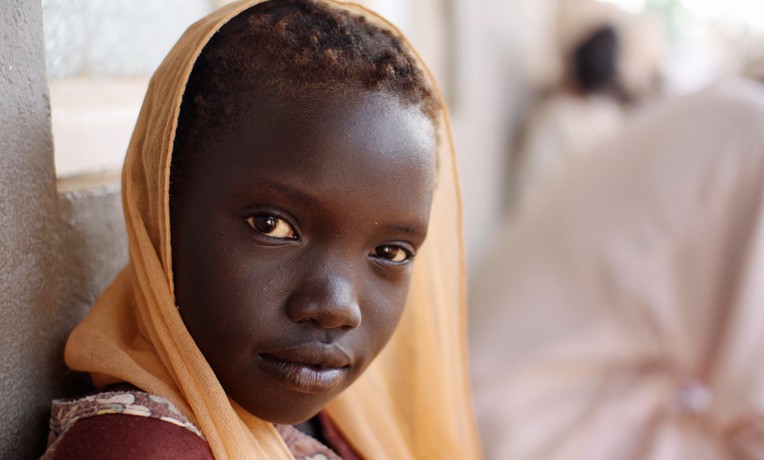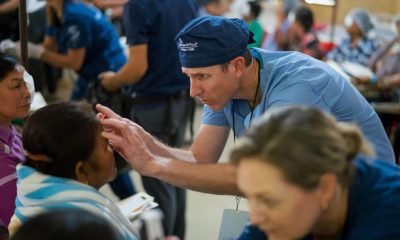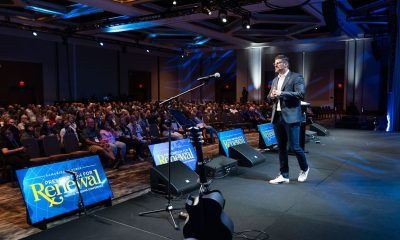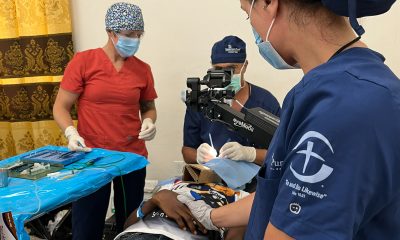Doctors in South Sudan perform simple operations to give eyesight to elderly refugees
The old man lay on the operating table, a microscope hanging above his head. A Kenyan eye doctor dressed in light blue scrubs sat on a rolling doctor’s chair next to the table, head bowed. I could hear him murmuring, praying over his first patient of the day.
It was just past 8:00 a.m., and in a few minutes, the marathon of cataract operations would begin. Hundreds of hopeful patients already sat lined up outside in the courtyard of the Maban County Hospital that Samaritan’s Purse operates in northern South Sudan. Some of the people in the courtyard had been waiting since the day before. They had all come with the same need and hope: sight.

A mother with her baby waiting her turn for cataract surgery
Nobody can remember the last time an eye doctor came through Maban County, South Sudan. If there ever was an eye specialist in the area, it’s been years. Maban is a town located in Upper Nile State, one of 10 states in South Sudan. It’s speckled with palm trees and crisscrossed with rivers and is home to more than 130,000 refugees and roughly 13,000 internally displaced people who have fled conflict in neighboring towns and nearby Sudan. Samaritan’s Purse has been operating in Maban County since 2011, helping to provide emergency food and medical help to refugees and local communities struggling for survival in the war-torn corner of South Sudan.
The eye campaign Samaritan’s Purse organized with eye specialists from World Gospel Mission and Tenwek Hospital in Kenya was the first ever in Maban and was greeted with much anticipation. Buses arrived each day, bringing loads of people from nearby refugee camps hoping for the chance to see again. When new people arrived, they were screened and then, if necessary, waited in line for an operation. In total, the eye specialist screened 1,430 people.
I stood out of the way while hospital staff scurried around the operating room, preparing patients for surgery. Refugees and community members waited, their wrinkled hands holding white pieces of paper with instructions for the doctors. Most of the patients were elderly, as cataracts generally form with normal aging. When the lens inside the eye wears out, it begins to cloud over, leading to loss of vision and clarity.
“Hey, Amy,” the doctor doing the pre-operation local anesthesia called over to me. “Have you ever seen an eye get poked with a needle?” I tried to watch but instead ended up squeezing my own eyes shut as the doctor efficiently prepared people for operation. After a small wait for the anesthesia to set in, patients were helped onto the operating table where the doctor removed the cloudy cataract and replaced it with a new corrective lens.
“Aren’t they scared at all?” I asked one of the doctors. “Everyone seems so calm.” The doctor laughed. He held a small metal tool in each hand and worked with steady proficiency. “They’re so full of hope that they will see again,” he said. “The hope overrides the fear. What do they have to lose?”
Faithful Hope

The doctors estimated that 80 to 90 percent of the patients they operated on were completely blind. Cataracts are common and easily treatable, but the people living in Maban County don’t have money or doctors for eye operations. The opportunity to receive a free operation that could restore sight was no small thing. Wanting to see again, elderly refugees and community members, mothers, grandfathers, and a few children who had congenital cataracts came to the hospital carrying the same hope.
A soldier wearing camouflage had escorted in the elderly man lying on the operating table into the room. He was a police commissioner, but on the operating table, the power of his rank meant nothing. Human need has a way of equalizing people and reminding them of their own frailty. He was completely vulnerable, trusting and hoping that the doctor could bring back his failing sight. He came with the same hope as the smallest refugee.
Fulfilled hope is a beautiful thing to witness. At the start of each day, all the patients who were operated on the day before again gathered in the hospital courtyard. Men sipped coffee in small tin mugs, and women wore bright-colored scarves wrapped around their heads. Most of the people had gauze taped over one of their eyes. Several doctors slowly made their way along the row of patients, removing gauze and checking the freshly fixed eyes.
An old man sat waiting quietly, a line of patients on either side of him. A doctor removed the bandage from his eye, revealing a closed eye surrounded by the wrinkles of a long life. The man looked up, slowly opening his eye, almost as if afraid. I watched as a smile slowly crept over his face, revealing crooked teeth.
“You can see?” the doctor asked. The man couldn’t understand English, but his face beamed brighter. He said nothing, as if the moment were sacred, and raised his hands in thanks to the doctor and to God. After years of blindness, he could see again. I couldn’t help but wonder what these new eyes would see and what they had seen before they went blind. I hope they get to see times of peace and beauty within their lifetime.





